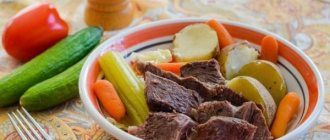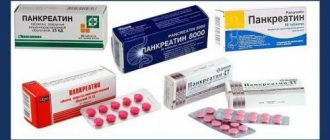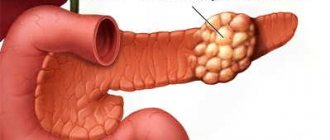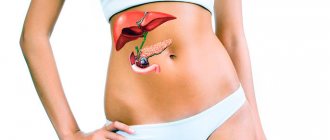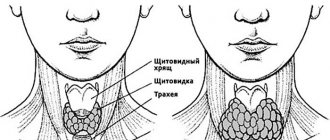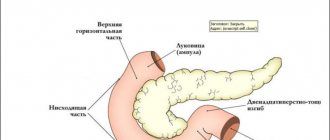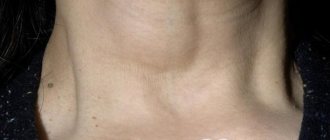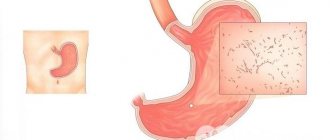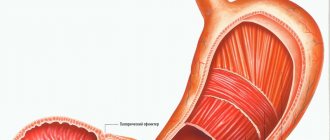Chronic pancreatitis is a recurrent inflammatory disease of the pancreas, which occurs with periods of exacerbation and remission. If periods of remission are relatively calm, painless and without symptoms, then exacerbation phases bring excruciating suffering to patients, forcing them to immediately consult a doctor. Treatment and first aid for exacerbation of chronic pancreatitis is carried out in a hospital under the supervision of a surgeon or gastroenterologist.
Even with a mild course of the disease, treatment at home is unacceptable. Pancreatitis is dangerous due to its complications. In order not to miss the deterioration of the patient’s condition, to conduct a full diagnosis and monitor the course of the disease over time, a patient with exacerbation of chronic pancreatitis is hospitalized in a hospital. In severe forms of the pathology, the patient is hospitalized in the intensive care unit, where he is given first aid and the issue of surgery is decided. For mild forms, go to the gastroenterology department. All this indicates the seriousness of the disease, so it is important to know the symptoms of exacerbation of chronic pancreatitis and the basic principles of first aid that you can provide to the victim.
Types of disease
The most common types are chronic and acute pancreatitis. The difference is that acute inflammation of the pancreas occurs for the first time and occurs quickly, sometimes with lightning speed.
Chronic pancreatitis occurs with alternating phases of remission and exacerbation. The interictal period proceeds, as a rule, without clinical manifestations. Exacerbation of chronic pancreatitis occurs in the same way as acute pancreatitis. And the management tactics for these two clinical situations are the same.
Diagnosis during exacerbation
In case of exacerbation, first of all, you should consult a doctor. If exacerbations occur frequently, manifest severe symptoms, and the acute phase lasts longer than 3-5 days, hospitalization may be required for a detailed examination.
Determination of pancreatic enzymes in blood serum and urine
Due to its simplicity and accessibility, this method is a screening method and is performed on all patients with abdominal pain. Most often, amylase content is determined
Ultrasound
Another minimally invasive and affordable diagnostic method. Its accuracy reaches 60-85%. The main signs detected during exacerbation of pancreatitis: enlargement of the organ, blurring of its contours and changes in the ECHO structure. However, the diagnostic value is manifested only with a comprehensive assessment of clinical data and ultrasound results. Isolated changes in the pancreas on ultrasound in the absence of symptoms cannot be the reason for the diagnosis.
CT (computed tomography)
The sensitivity of the method reaches 75-90%. The gold standard is multispectral CT with intravenous contrast.
Endoscopic retrograde cholangiopancreatography
Endoscopic retrograde cholangiopancreatography
The method is quite complex and is carried out in a hospital setting, but it provides reliable information in 95% of cases. During the examination, a contrast agent is injected into the pancreas and the condition of the ducts is assessed, as well as the rate of their emptying using radiography.
Coprogram
Allows you to evaluate the excretory function of the pancreas. During an exacerbation of chronic pancreatitis in the stool the following is detected:
- Steatorrhea - the presence of neutral fats
- Creatorhea - the presence of muscle fibers and connective tissue, indicating impaired protein digestion
- Amilorrhea - undigested extracellular starch is detected
Glucose tolerance test
Based on its results, the preservation of endocrine function is assessed
Stages and degrees
Exacerbation of pancreatitis (symptoms and treatment of which depend on the severity) occurs with changing phases. During the course of the disease, there are several stages or stages.
| First phase | Represents pancreatic colic. This is a reversible situation when the manifestations of pain come first. When it is adequately relieved with antispasmodics or ganglion blockers, the symptoms do not worsen. |
| Early endogenous intoxication | The temperature rises and nausea may occur. |
| Stage of general inflammatory changes | Increases in body temperature at febrile levels may be observed, and blood pressure levels decrease due to excessive activation of the kallikrein-kinin system. The heart rate increases. |
| Stage of local purulent-inflammatory changes | Accompanied by destruction of pancreatic tissue and infection. Local or widespread peritonitis may form. At the same stage, abscesses or phlegmons of adjacent cellular spaces develop. |
Folk remedies for disease prevention
During the interictal period (the stage of remission of inflammation), the doctor may advise the patient to take a course of certain alternative medicines at home to prevent exacerbations. The most effective, judging by patient reviews, folk remedies, in the absence of contraindications and a tendency to allergies, are the following:
- cranberry juice,
- blueberry decoction from dried parts of the plant: leaves, herbs and berries,
- infusion of medicinal herbal collection (from chamomile flowers, immortelle, hawthorn, dill leaves and mint),
- decoction of fireweed leaves.
Symptoms
Clinically, the disease manifests itself as an acute abdomen. This is a pronounced pain syndrome. It can have a clear localization. As a rule, this is the upper abdomen, or more precisely, the left hypochondrium. Here is the projection of the tail of the pancreas.
Symptoms of exacerbation of chronic inflammation of the pancreas (pancreatitis).
Mondor's triad is diagnostically significant for pancreatitis. In addition to pain, it is characterized by bloating and nausea with vomiting.
The combination of these signs most likely indicates damage to the pancreas.
Exacerbation of pancreatitis (symptoms and treatment are varied) is accompanied by pathognomonic spots on the face, skin of the torso and abdomen.
The so-called Mondor's symptom is common. It appears as purple spots on the face.
The appearance of the same spots on the sides of the abdomen is referred to as the Gray-Turner symptom.
By palpation, the doctor can also determine a number of specific symptoms. First of all, there is severe pain in the area where the last rib meets the spine, more so on the left.
The symptom is called Mayo-Robson. The Voskresensky sign is also distinguished. The doctor does not feel the pulsating abdominal aorta. This phenomenon is caused by an enlargement of the pancreas due to edema and infiltration.
Particular attention is paid to signs indicating the onset of peritonitis. The Shchetkin-Blumberg symptom is the most common syndrome specific to this condition. When the doctor sharply removes his hand from the abdomen after palpation, the patient experiences sharp pain. During auscultation, bowel sounds are no longer heard.
Diet
For pain, increased fermentation and fermenturia, fasting for 1-3 days is recommended. During this period, it is recommended to drink rosehip decoction, alkaline mineral water, and weak tea. Parenteral nutrition is sometimes used to prevent hypovolemic shock.
Afterwards a protein-carbohydrate diet is prescribed. Food is consumed in pureed warm form at least 4 times a day. Preference is given to vegetable puree with the addition of ground boiled meat, liquid porridges, and steamed cutlets made from lean meats and fish. Butter is added only to prepared dishes.
For pancreatitis, a protein-carbohydrate diet is prescribed. Food is consumed pureed at least 4 times a day. Preference is given to vegetable puree with the addition of ground boiled meat, liquid porridges, and steamed cutlets made from lean meats and fish.
Reasons for appearance
Exacerbation of chronic pancreatitis (or acute pancreatitis) in most cases is associated with excessive alcohol consumption. In second place among the etiological factors causing symptoms of inflammation of the pancreas are nutritional factors. This is the consumption of excess fats, carbohydrates, salty and spicy foods. Treatment requires adherence to strict dietary recommendations.
In women, cholecystitis is in first place in terms of frequency of occurrence among the etiological factors of pancreatitis. This is especially true for calculous forms (in combination with cholelithiasis).
Other factors include viral pathology and traumatic organ damage. Reactive damage in diseases of other organs of the gastrointestinal tract is not excluded.
Causes
Considering the extensive list of functions performed by the pancreas, disruption of its functioning leads to serious health problems and a deterioration in the quality of life.
According to the modern classification, the following etiological and trigger causes of the occurrence and progression of chronic pancreatitis are called:
- Toxic consumption of alcohol, drugs, poisoning with salts of heavy metals, certain medications. There are also studies showing that smokers develop the disease more often.
- Hereditary revealed a large number of chromosomal mutations leading to the development of early and rapidly progressive pancreatitis.
- Obstruction of the ducts due to mechanical damage, cancer and insufficiency of the sphincter of Oddi.
- Metabolic such as cystic fibrosis, chronic renal failure.
- Immunological production of autoantibodies to one's own cells manifests itself in primary autoimmune pancreatitis and is a consequence of other systemic diseases.
alcohol is prohibited for pancreatitis
All etiological factors are divided conditionally into controllable and uncontrollable. Among the causes of chronic pancreatitis and its exacerbations, only the first group can be corrected. Therefore, a person who has a history of such a diagnosis, regardless of the frequency of exacerbations, must completely change his lifestyle, stop drinking alcohol and reduce the functional load on the organs of the digestive tract.
Diagnostics
First of all, if pancreatitis is suspected, a biochemical blood test and a general blood and urine test should be evaluated. They are feasible even at night if an ambulance takes the patient to the hospital emergency department. Therefore, if a paramedic or emergency doctor suspects acute pancreatitis and suggests hospitalization, under no circumstances should you refuse.
A general blood test reveals a high level of leukocytes, a shift to the left is detected in the leukoformula, young forms of granulocytes appear, which indicates an active and intense inflammatory process. The ESR (ROE) indicator increases.
With severe pancreatic necrosis, the blood thickens, the hematocrit increases (above 55% in men, above 50% in women). Urinalysis should be supplemented by determination of diastase. If the values exceed 64 U/l, one should think about inflammation of the pancreas and further conduct research to exclude this particular pathology.
The biochemical blood test should be quite broad. In this case, not only indicators specific to pancreatic pathology are important, but also others, because it is very important to carry out a differential diagnosis of other conditions accompanied by similar symptoms.
Blood amylase, phospholipase A2, alpha antitrypsin, as well as procalcitonin levels and blood calcium concentrations are determined. To exclude liver pathology, the content of ALT, AST, the level of total bilirubin and its fractions is considered, and thymol or other sediment tests are performed.
If there are manifestations in which it is difficult to exclude disease of the gallbladder and other bile ducts, GGTP and alkaline phosphatase are determined. C-reactive protein, when significantly higher than normal levels, indicates necrosis of pancreatic tissue.
The next examination technique is to conduct an ultrasound. Ultrasound examination allows you to assess the condition, topography, relative position of the abdominal organs, retroperitoneal space, and the pelvis. This allows us to indirectly judge which organ is involved in the pathological process and causes the corresponding symptoms.
In the presence of pancreatitis, a pronounced increase in the size of the organ, as well as its individual parts, is detected. At the same time, the echogenic structure is heterogeneous. The contours of the gland and its ducts are uneven and unclear. Sometimes, in the presence of complications, a liquid formation is visualized in the projection of the cellular spaces.
The differential diagnosis of the condition of “acute abdomen” is helped by plain radiography of the abdominal cavity. It is necessary to exclude a perforated gastric ulcer or intestinal obstruction. Contrast techniques are designed to exclude vascular diseases, as well as the presence of gallstones.
The “gold” standard in diagnosing pancreatitis is laparoscopy . This is a minimally invasive intervention method. It is he who is called upon to carry out the most clear differential diagnosis, including at the stage of the process of inflammation of the pancreas. It is carried out under anesthesia; through 4 protocols, endoscopes or other imaging equipment are inserted into the abdominal cavity.
The appearance of the organ, as well as the cellular spaces and other organs in the neighborhood surrounding it, is assessed. This technique allows you to see what type of pancreatitis occurs in this case: hemorrhagic or fatty. If there is inflammation of the cellular spaces, laparoscopic intervention allows you to see its signs.
An equally sensitive technique in diagnosing pancreatitis is tomography. When performing a CT scan, it is possible to differentiate cystic and purulent cavities from dense infiltrates. This is important in terms of tactics for further patient management.
For better visualization, intravenous administration of a contrast compound (Ultravist) is used. Magnetic resonance imaging has less sensitivity and less radiation exposure. However, MRI helps to better examine dense structures that have not undergone destruction and melting.
Prevention of the development of pancreatitis in adults and children
Inflammation of the pancreas can appear at any age - in both adults and children - for various reasons. The main risk factors for developing pancreatitis are related to the rhythm of life and general problems:
- unhealthy diet with excessive consumption of fast food, fatty, spicy foods, sweets in the diet,
- bad habits, especially alcohol abuse, smoking,
- uncontrolled use of certain medications (glucocorticoid hormones, diuretics, non-steroidal anti-inflammatory drugs),
- non-compliance with the work and rest schedule,
- frequent stress,
- chronic diseases of other gastrointestinal tract organs,
- obesity and other metabolic pathologies,
- hereditary predisposition.
Primary prevention of disease occurrence
Primary prevention is the prevention of problems with the pancreas in a healthy person. For effective prevention, timely elimination of all causes that can lead to pancreatitis is necessary. Basic measures of primary prevention:
- Compliance with the principles of proper nutrition.
- Quitting smoking and drinking alcohol.
- Treatment of diseases of the digestive tract (gastritis, hepatitis, cholecystitis, duodenitis, stomach ulcers, cholelithiasis and others) as prescribed by a specialist and under his supervision.
- Avoiding unnecessary physical and psychological stress.
- Regular exercise, maintaining an active lifestyle, constantly maintaining a normal weight.
If there is a hereditary predisposition to problems with the pancreas, diagnosed gallstone disease and other gastrointestinal diseases, a person must undergo regular medical examinations, be observed by a gastroenterologist and follow all his recommendations, especially if complaints from the digestive organs appear.
These activities lead to overall health of the body, increased immunity and defenses, improved blood supply to all organs and tissues, including the pancreas, elimination of stagnation of secretions in the gland and acceleration of lymphatic drainage. All these processes are necessary for the effective prevention of all diseases of the digestive tract.
Prevention of disease in children
Pancreatitis often develops in children, especially in the presence of risk factors for the disease, the main of which is poor diet and daily routine.
In order to prevent digestive problems in a child, from childhood one should instill in him the need to lead a healthy lifestyle, not smoke in his presence, the parents themselves should eat right and instill a love of sports.
A baby up to one year old should be fed breast milk for as long as possible, since breastfeeding promotes the proper morphofunctional development of the digestive tract, and this is the best prevention of most gastrointestinal diseases.
When introducing complementary foods, parents must adhere to the recommendations of the World Health Organization (WHO). The child should be fed only with approved foods from the list, which will be given by the pediatrician after consultation, examination, and identification of allergies to any foods or concomitant diseases.
Older children and teenagers should not be fed fast food, spicy, fatty, fried foods, or given a lot of sweets or soda in large quantities. It is advisable to completely exclude such products from the child’s diet.
When to see a doctor
Inflammation of the pancreas is fraught with a gradual decrease in the function of the organ, and the subsequent need to constantly take enzyme replacement therapy. Another possible negative consequence is impaired insulin secretion. This means that with pancreatitis, the entire carbohydrate metabolism is at risk, which increases the likelihood of developing diabetes.
An exacerbation of pancreatitis (symptoms and treatment can only be determined in a hospital) should be a reason to immediately consult a doctor.
If you are concerned about the following symptoms, you should call an ambulance:
- severe pain in the upper abdomen, more on the left;
- nausea and vomiting that do not bring any relief;
- rise in temperature of febrile or subfebrile level;
- unstable, frequent stools, with undigested pieces of food;
- increased heart rate and decreased blood pressure against the background of the above symptoms.
A gastroenterologist or therapist is consulted if chronic inflammation of the pancreas worsens. The diet and replacement therapy are adjusted, and if necessary, further examination is prescribed.
Main symptoms
All symptoms of the clinical picture of exacerbation of pancreatitis develop already on the first day, forcing the patient to immediately seek help from a doctor. Worsening of the disease can be recognized by the following symptoms:
- Excruciating pain throughout the abdomen, with a predominant localization in the epigastric region. The pain is girdling in nature or radiates to the back, lower back, shoulder blade, right and left hypochondrium. The pain syndrome is not relieved by taking conventional medications. The patient cannot find a place for himself, taking a forced position (lying on his side with his knees brought to the body or the “embryo” position). Pain occurs after an error in the diet: drinking alcoholic beverages, fatty foods, rich food.
- Vomiting that precedes pain or occurs at the height of pain. A distinctive feature of this symptom is that vomiting does not bring relief. On the contrary, the patient notes ongoing nausea.
- Flatulence is increased gas formation in the intestines.
- Liquid, pasty, frequent yellow stools with a large amount of fat (steatorrhea).
- If a patient has biliary-dependent pancreatitis, then in most cases there is a bitter taste in the mouth, a bitter taste in the vomit. In some cases, examination reveals icteric staining of the sclera, mucous membranes and skin.
- Increased body temperature, feeling hot, weakness, lethargy.
Prevention
The basis is the elimination of factors that provoke exacerbation. For the most part, this concerns nutritional habits. It is necessary to exclude spicy, fried and salty foods. It is worth adhering to diet No. 5 according to Pevzner.
Alcohol and alcohol-containing drinks are completely excluded. Any provocation can cause an exacerbation, which again will lead to hospitalization and, possibly, surgery. If there are problems with the gallbladder, they should be addressed as soon as possible. Gallstone disease is one of the risk factors for the development of exacerbations of chronic pancreatitis.
Prognosis for recovery
It is important to realize that the exacerbation itself usually does not last long, a maximum of a week, but the disappearance of symptoms does not indicate recovery. It is impossible to achieve a complete cure for pancreatitis. The task of the patient and the doctor through joint efforts is to prevent the occurrence of exacerbations and the development of functional failure of the organ. This requires a complete cessation of bad habits, lifelong adherence to a diet and periodic examinations according to the schedule proposed by the attending physician.
Treatment methods
If inflammation of the pancreas is suspected, hospitalization in the surgical department is indicated. It is necessary to take a comprehensive approach to treatment. It includes dietary recommendations, drug pathogenetic therapy. If necessary, surgical intervention is performed.
Medications
In case of exacerbation of chronic inflammation of the pancreas, as well as in acute pancreatitis, the approach to treatment is similar. If there is a confirmed disease, pathogenetic treatment is prescribed. First of all, it is necessary to reduce the effects of intoxication. For this purpose, a large amount of colloidal and crystalloid solutions is introduced.
These are the solutions:
- glucose;
- sodium chloride;
- rheopolyglucin;
- hydroxyethyl starch.
To reduce enzymatic aggression, so-called antikikin agents are introduced. This is Gordox, Contrical, or Trasylol. It is based on aprotinin, which blocks the production of enzymes by pancreatic cells.
The dosage is selected depending on the severity of the condition. For the same purpose, the appointment of Octreotide or Sandostatin is effective. These medications are prescribed 2-3 times a day subcutaneously, the maximum daily dose is 150-300 mcg.
When there is a threat of infection, it is advisable to add antibiotics. Experienced doctors do not take risks and therefore, even with a low probability of infection, prescribe preventative antibacterial agents with a wide spectrum of action.
In addition to the above drugs, antisecretory drugs are indicated for pancreatitis. They minimize the secretion of gastric juice and hydrochloric acid.
Are used:
- Kvamatel;
- Omez;
- Ranitidine;
- Nexium.
Their analogues are also used. First, to achieve greater effectiveness, the drugs are injected into a vein by drip. Then, after stabilization of the condition, oral administration is continued.
The pain syndrome is relieved with antispasmodics. These are No-Shpa, Drotaverin, Baralgin. Both intramuscular and intravenous administration are possible. Sometimes droppers with the addition of Novocaine are prescribed. This allows you to reduce pain impulses and avoid painful shock.
For the same purpose, ganglion blockers and anticholinergics are used. Platiphylline and atropine are effective. Despite the fact that the use of non-steroidal anti-inflammatory drugs is not recommended for exacerbation of pancreatic diseases, sometimes regular Analgin (Metamizole sodium) is used to reduce pain impulses.
Traditional methods
Non-traditional methods are contraindicated in an acute situation. In this case, there is simply no time and resources for experiments. It is better to rely on proven treatment methods in a surgical setting.
For chronic disease, there are several effective folk recipes. Jelly made from sprouted oat seeds has an enveloping, soothing effect. They are crushed, a small amount of water is added, and the resulting mixture is boiled. You can use it for up to a month.
A decoction of burdock leaves and rose hips also relieves spasms, reduces the severity of inflammation in the affected organ, and improves digestion in general.
Diet
The acute phase of pancreatitis requires fasting for 1-3 days. When the danger of developing serious infectious complications and pancreatic necrosis has passed, you can slowly expand the menu. First, you can have slimy soups and pureed porridges. All dishes are made exclusively with water without adding milk. Including an omelette. Under no circumstances are flour or fresh bread allowed. An alternative is white crackers.
Further expansion of the treatment table involves the inclusion of low-fat varieties of fish and meat in the diet. Products are steamed. Hot spices are prohibited. They can be replaced with herbs. Frequency of meals - up to 6 times during the day. To protect the gastrointestinal tract, dishes should not be very cold or very hot.
Prohibited foods include those that cause excess gas and bloating. These include cabbage, legumes, and ingredients with a lot of fiber. Strong coffee and soda are excluded from the diet, as well as alcohol.
Other methods
Surgical intervention is justified for purulent complications: abscess, phlegmon of cellular spaces, peritonitis. Otherwise, death is inevitable.
When there is aseptic necrosis or the absence of infectious damage to pancreatic tissue, surgeons usually maintain an observant, wait-and-see attitude. When, against the background of adequate pathogenetic therapy, the patient’s condition does not improve, hemodynamics are unstable, and they resort to surgery.
This may be resection of a part of the organ, or it may be abdominization (a gentle option). In any case, drainage of the abdominal cavity is carried out to prevent secondary infection and the formation of subphrenic and pelvic abscesses and peritonitis.
Lifestyle and prevention of exacerbations
In order to prevent another exacerbation, it is necessary to adhere to the principles of proper and healthy nutrition, following all the doctor’s recommendations. Quitting alcohol and smoking will also significantly help achieve lasting remission of a chronic disease.
Limit the amount of fat you consume as much as possible. Reduce the caloric content of your diet to prevent excess weight gain. Taking medications, as well as treatment with traditional methods of treatment, is allowed only after consultation with a specialist. It is required to undergo an annual preventive examination by a gastroenterologist in order to monitor the dynamics of the pathological process and prevent the occurrence of complications and exacerbations.
Possible complications
When the conditionally pathogenic flora has not yet been activated, and the inflammation process is still aseptic (non-infectious), complications such as infiltration of fiber that surrounds the pancreas are possible. This is a limited aseptic inflammation, but it can spread to nearby cellular spaces. We are talking about phlegmon of the pelvis, perinephric tissue.
Without the participation of an infectious agent, inflammation of the peritoneal layers develops without treatment. Otherwise, the situation is called peritonitis. From aseptic it quickly becomes bacterial and purulent. And then the threat of sepsis and multiple organ failure increases, when all vital organs and systems fail.
Enzymatic autoaggression is dangerous because under the influence of an aggressive environment, perforations of nearby organs and vascular structures can form. Intestinal fistulas develop.
But vascular damage is more dangerous. If it is an artery or vein in the wall of the stomach or intestines, then this is a less dangerous bleeding. But when large branches of the abdominal aorta are affected, the threat of hemorrhagic shock and death from massive blood loss increases.
Exacerbation of pancreatitis (symptoms and treatment depend on the presence of complications and their nature) often causes the formation of pancreatic cysts. Over time, with the addition of a bacterial component, these initially liquid and sterile formations may suppurate. Inflamed cysts are subject to surgical treatment.
Systemic complications are more dangerous without treatment. Most often, so-called pancreatogenic shock develops. This is a pronounced hemodynamic disturbance as a result of severe pain impulses. A significant contribution is made by the infectious-toxic factor and enzymatic autoaggression.
Septic shock is a logical continuation of peritonitis or pancreatitis complicated by infection. It also disrupts the blood supply to vital organs. Multiple organ failure is considered as one of the stages of shock. At this stage, it is usually not possible to save the patient even in a specialized intensive care unit.
Exacerbation of chronic pancreatitis is a condition that requires dynamic monitoring and active treatment similar to the acute form. Symptoms of peritonitis and infection require surgical treatment. During the interstitial period, replacement therapy and dietary recommendations are prescribed.
Article design: Vladimir the Great
Life forecast
Life expectancy with chronic pancreatitis depends on several factors:
- the age of the patient (after 70 years, the patient’s risk of death is much higher);
- general condition of the pancreas;
- medical history and frequency of consumption of alcoholic beverages;
- the degree of organ damage and the presence of complications, in particular diabetes.
For example, a 30-year-old man who does not abuse alcohol can live another 40 years. Whereas the life of a 50-year-old person suffering from alcoholism will be reduced to 10-15 years. This difference is explained by the fact that it is difficult for an organ damaged by pancreatitis to cope with the additional load played by alcohol. He shifts his task to neighboring organs, which, due to age and lifestyle, are already in a deplorable state.
When the pancreas dies, mortality is more than 60% of cases, and most of them occur due to the fact that neighboring organs cannot cope with the inflammatory reaction. Various complications accompanying the disease also often lead to death.
Medications
Medicines can provoke an exacerbation of the disease, an inflammatory process in the pancreas.
Medicines that can only be taken under the supervision of a doctor:
- narcotic analgesics;
- antiepileptic drugs;
- oral contraceptives;
- antidiabetic agents;
- immunosuppressive drugs;
- antibacterial drugs;
- diuretics;
- statins;
- steroids;
- antimicrobial sulfonamide groups;
- drugs to lower blood pressure;
- immunostimulants.
The pancreas is very difficult to treat; the disease is easier to avoid than to cure.
Main types of pancreatitis prevention
How to prevent pancreatitis and related complications in the body?
To prevent the onset and progression of the disease, pancreatitis is prevented.
There are two types of preventive measures - primary and secondary.
Primary prevention is a set of measures aimed at preventing the occurrence of an inflammatory process in a healthy gland.
Primary prevention of acute pancreatitis is based on the use of measures that are aimed at eliminating the root causes that contribute to the formation of a pathological condition in the pancreas tissues.
Secondary preventive measures are measures aimed at preventing the development of relapses of the disease and complications if the body already has a chronic form of pancreatitis.
The main component of primary and secondary prevention is the implementation of anti-inflammatory measures.
Such measures are aimed at preventing the occurrence of an inflammatory process or stopping an existing one in order to prevent its complication.
Symptoms of chronic pancreatitis
Symptoms of pancreatitis are often ignored, and treatment in adults is delayed until the first serious attack.
Basically, the initial pathological changes in the tissues of the pancreas during the onset of chronic pancreatitis pass without obvious manifestations. Or the signs of chronic pancreatitis are weak and nonspecific. With the development of the initial identified aggravation, painful changes are already quite significant.
The patient's main complaint is unbearable painful discomfort. Its formation is determined by the area of damage to the pancreas - on the left, right side under the rib or in the middle of the ribs.
Often, painful symptoms of chronic pancreatitis develop an hour after eating, especially when spicy or fatty foods were consumed. The pain may intensify if the patient lies down, radiating under the area of the scapula, shoulder on the left, the lower part of the peritoneum or the cardiac area. The only comfortable position during attacks is sitting, leaning forward.
When chronic pancreatitis forms, symptoms appear as follows:
- when the entire organ is affected, the pain syndrome is of a girdling nature, covering the entire peritoneal area;
- damage to the head is manifested by pain in the hypochondrium on the right;
- when pancreatitis invades the body, pain is felt under the epigastric region;
- with inflammation of the tail area, the pain is localized on the left side or on the right under the rib from the navel.
Based on the totality of symptoms, you can understand how to determine chronic pancreatitis in adults:
- flatulence, belching.
- stool instability – alternating diarrhea with constipation is noted.
- the nature of the stool is pronounced pancreatic: foul-smelling, foaming, greasy (poorly washed off the walls of the toilet).
- nausea, vomiting.
- lack of appetite
- diabetes mellitus, then, on the contrary, a strong feeling of hunger and thirst.
- weight loss, depletion of fatty tissue in the area of the gland projection is noted.
- salivation.
- coated tongue.
When the gland hurts, there is a decrease in pancreatic enzymes, and the activity of the entire digestive structure changes. The main symptoms accompanying the chronic form of pancreatitis are esophagitis and belching.
Symptoms and complications of pancreatitis
The symptoms of acute and chronic pancreatitis differ exactly, as do the features of its course and possible complications. The symptoms of chronic pancreatitis are often erased. Signs of an acute illness are always pronounced, but it is important not only to immediately consult a doctor, but also to exclude the development of other equally dangerous diseases, for example, acute cholecystitis or appendicitis.
Symptoms of acute pancreatitis
Activating in the pancreas itself, enzymes in the digestive juice affect its tissues. Thus, the action of lipase, designed to break down fats, leads to fatty degeneration of cells. Trypsin, which digests protein, causes various chemical reactions, leading to swelling of the pancreas tissue and necrosis (death) of its cells. At first, necrosis is aseptic; later it may be accompanied by infections, causing the formation of purulent foci. Common symptoms of acute pancreatitis include:
- Pain, often girdling, in the right or left hypochondrium. The painful sensations are intense and cannot be eliminated with the help of medications, even with timely initiation of treatment on the first day. Some patients may develop pain shock during an attack of acute pancreatitis.
- Complete lack of appetite, nausea and indomitable vomiting, which does not bring relief to the patient. Vomit usually consists of stomach contents and bile.
- Increased body temperature (more than 38°C), increased heart rate (more than 90 beats/min.) and respiration, decreased blood pressure (less than 90 mm/Hg).
- Tension of the abdominal wall in the area under the costal arch on the left.
- Bloating, clearly felt in the upper abdomen. The appearance of this symptom is due to a disruption in the functioning of the digestive system.
In addition, acute pancreatitis is characterized by a bluish color of the skin or the development of mechanical jaundice if the cause of the disease is cholelithiasis.
Symptoms of chronic pancreatitis
Pain during exacerbations of chronic pancreatitis is localized, as a rule, in the area of the right or left hypochondrium, and radiates to the back, acquiring a girdling character. Exacerbation of pancreatitis can be provoked by drinking alcohol, fatty or spicy foods. The pain that occurs during exacerbations develops against the background of an inflammatory process affecting the nerve endings of the organ, as well as an increase in the size of the pancreas. In addition to pronounced painful sensations, patients with exacerbations of chronic pancreatitis experience:
- Bloating, belching, diarrhea, nausea and vomiting. These symptoms are caused by a lack of enzymes involved in digestion.
- Loss of body weight and deterioration in the general condition of the body. Due to impaired metabolism of proteins, carbohydrates and fats, patients with chronic pancreatitis experience severe dry skin, vitamin deficiency, brittle nails, development of anemia, etc.
- Increased gas formation, stool disorders. This happens due to poor digestion of food and excessively active formation of bacteria in it, disrupting the normal intestinal microflora.
If the exacerbation of pancreatitis is pronounced, the symptoms of the disease in chronic and acute forms are similar to each other. Against the background of a sudden exacerbation of the inflammatory process, necrosis of pancreatic tissue may develop, causing severe acute pain and requiring urgent hospitalization.
Cholecystitis and pancreatitis
Cholecystitis, pancreatitis are inflammatory diseases of the digestive tract. With cholecystitis, the gallbladder is exposed to inflammation, and with pancreatitis, the pancreatic tissue is affected. Both processes can occur either separately or be interrelated. There is even a term for both diseases that occur in combination - cholecystopancreatitis.
Cholecystitis and pancreatitis cause the patient pain in the upper abdomen. But their main difference is that with inflammation of the gallbladder, the pain is localized in the right hypochondrium, and with inflammation of the pancreas it is girdling.
With pancreatitis, the patient feels heaviness in the abdomen, aggravated after meals, bloating and stool disturbance are observed. It is extremely difficult to distinguish cholecystitis from pancreatitis by external signs. Diagnosis is possible only after differential diagnosis.
Complications of pancreatitis
As with almost any disease, timely consultation with a doctor and the beginning of prescribed treatment for any form of pancreatitis will reduce the likelihood of complications to almost zero and will slow down destructive processes in one of the main organs of the digestive system. Complications of an acute disease can develop in the shortest possible time and even cost the patient his life. Chronic pancreatitis is more “insidious”, and its complications develop as the pancreatic tissues are damaged and they lose their functions.
Complications of chronic pancreatitis
The main complications of chronic inflammatory process in pancreatic tissues are:
- the development of diabetes mellitus, which occurs against the background of insufficient production of the hormone insulin;
- general exhaustion of the body, in which nutrients entering the body with food cannot be fully absorbed due to a lack of pancreatic enzymes;
- the development of diseases of various organs of the gastrointestinal tract, for example, cholecystitis or duodenal ulcer;
- formation of an acquired cyst in the tissues of the glandular organ;
- obstructive jaundice, which appears against the background of compression of the bile ducts.
With exacerbations of pancreatitis, infectious processes can develop, both in the tissues of the pancreas itself and beyond. In the absence of proper treatment and diet, abscesses and bleeding may develop in pancreatitis.
Complications of an acute disease
In acute inflammation of the pancreas, complications may have early or late manifestation. With early complications that develop immediately at the beginning of an attack, the following may develop:
- hypovolemic shock, leading to a lack of oxygen in the tissues of all organs of the digestive system;
- liver and kidney failure caused by the toxic effects of digestive enzymes;
- peritonitis, which can be either aseptic or purulent, developing against the background of infection joining the inflammatory process;
- cardiovascular or respiratory failure, etc.
The development of late complications in acute pancreatitis occurs mainly against the background of infections. Such complications include sepsis, abdominal abscesses, fistula formation, purulent inflammation of nearby tissues, formation of pancreatic pseudocysts, bleeding, etc.
Symptoms of exacerbation of the disease
In many patients, chronic pancreatitis occurs completely without any symptoms; in some cases, a person complains of periodic diarrhea or pain in the left hypochondrium. However, with an exacerbation, the symptoms of the pathology begin to appear quite clearly and quickly.
On the first day of the attack, the patient’s health deteriorates sharply, forcing him to take appropriate medications or call an ambulance.
Characteristic signs of exacerbation of chronic pancreatitis:
- Severe pain, which can be dull or sharp in the abdominal cavity without clear localization, worsens after eating and radiates to the back.
- Frequent diarrhea mixed with fatty particles in the stool.
- Feeling of bitterness in the mouth.
- Vomiting interspersed with bile, difficult to eliminate with medications.
- Severe nausea.
- Loss of appetite.
- White coating on the tongue.
All of the above signs can appear either as a whole bunch or individually. If a person suffers from severe, sharp pain, then dyspeptic syndrome may occur, in which the patient’s well-being rapidly deteriorates.
A pronounced dyspeptic set of symptoms can lead to rapid weight loss; within 7-14 days the patient loses about 8 kg of weight. In another case, when a person develops a pathological appetite, the development of diabetes mellitus should be suspected. In addition, the weaker the severity of the attack, the longer the duration of its presence; in this case, the aggravation may last several weeks.
What to do in case of exacerbation of chronic pancreatitis, which manifests itself as pain and dyspeptic symptoms? The best option is to immediately contact a gastroenterologist. If the pain is very high and the vomiting does not stop, you should call for medical help, since a violation of the water-electrolyte balance is extremely dangerous for a person. In addition, an attack can provoke partial destruction (destruction) of the pancreas, in which case surgical intervention will be required.
With a moderate exacerbation (mild symptoms), when a relapse is manifested by a dull pain, frequent bowel movements and nausea, you can endure it until the morning, and then go to the clinic. You cannot self-medicate without consulting a gastroenterologist; this action accelerates the breakdown of organ tissue, which begins to be replaced by connective or fatty tissue. In the future, this can cause improper functioning of the digestive system and the development of diabetes.
For women expecting the birth of a baby, signs of exacerbation during pregnancy manifest themselves in the classic version:
- Pain.
- Vomit.
- Nausea.
- Fever.
- Jaundice.
The problem of diagnosing an exacerbation of the disease in such patients is complicated by the fact that it can be easily confused with toxicosis, which affects almost all pregnant women. Therefore, for any signs that negatively affect your well-being, medical consultation is necessary.
Comments
To be able to leave comments, please register or log in to the site.
The inflammatory process occurring in the tissues of the pancreas can cause severe discomfort and serious complications in the functioning of the entire body in humans.
Inflammation of the gland tissue is called pancreatitis.
In the event of the development of this pathology, almost all functions assigned to the organ are disrupted.
The most characteristic symptoms of the disease are the following:
- debilitating pain;
- intoxication of the body;
- the appearance of a feeling of nausea;
- the urge to vomit;
The progression of the disease can provoke death.
Diet and nutrition principles
In adults, the disease becomes chronic, which means that nutrition should be given due attention, since it can prevent exacerbations. Each exacerbation entails the replacement of normally functioning gland tissue with fibrous tissue. Therefore, over the years, the patient develops exocrine and intrasecretory gland insufficiency.
Basic principles of nutrition for chronic pancreatitis:
- Diet No. 5p for chronic pancreatitis involves introducing more protein foods into the diet by eliminating fatty foods and carbohydrates. It is also necessary to avoid coarse plant fibers and fatty meats.
- Fried foods are not allowed. It is recommended to cook food in a double boiler, stew and bake in its own juice.
- All foods that cause dyspepsia and enhance the production of enzymes are also excluded from the menu.
- When a patient is on a chronic pancreatitis diet, food should be balanced in composition; dishes should be served warm and semi-liquid.
- Meals are fractional, consisting of 5-6 meals, with small portions.
- A complete ban on the consumption of alcoholic beverages eliminates the main danger factor for the pancreas.
- New foods should be introduced into the diet carefully, in small portions.
- at the slightest discomfort, you should refuse until the functioning of the pancreas is more completely stabilized;
- The recommendation to chew food thoroughly is also appropriate for a healthy body, but if you have a disease of the pancreas, this rule should be observed especially carefully, even if puree soup is served.
The diet for exacerbation of chronic pancreatitis, despite the restrictions, is very diverse. It is allowed to include in the diet:
- lean meat and poultry;
- boiled lean fish;
- vegetarian pureed vegetable soups;
- vegetarian soups with rice, noodles, buckwheat, semolina, oatmeal;
- boiled pureed vegetables (potatoes, carrots, zucchini, cauliflower, pumpkin);
- omelettes from 2 eggs;
- low-fat dairy products, non-acidic and low-fat cottage cheese, sour cream and cream in moderation, fermented milk products;
- ripe fruits with low acidity, pureed berries, baked apples;
- compotes and weak tea with lemon;
- moderate amount of butter and vegetable oil;
- porridge prepared with water and milk in a 1:1 ratio;
- boiled pasta;
- sugar-free cookies and homemade wheat bread crackers.
Patients are contraindicated in dishes with a juice effect:
- meat,
- bone,
- mushroom and fish broths,
- fried foods.
It is fundamentally important to avoid alcoholic beverages, since they are strong stimulants of pancreatic secretion.
During the period of remission, the list of products expands and the inclusion of vegetables and fruits in raw form is indicated. Vegetables are used in salads, side dishes, vinaigrettes and as independent dishes. In addition to porridges, you can make pilaf with dried fruits and boiled meat, pasta, and cereals. Soups are prepared without puree and beetroot soup, borscht and cabbage soup are carefully introduced. Homemade sauces and spices are used to improve the taste.
For chronic pancreatitis, a therapeutic course of mineral water is often prescribed. To achieve the effect, water is drunk not to quench thirst, but according to the recommendations for intake, certain types and according to the specified system.
A course of taking water of the Essentuki No. 4, Borjomi and Smirnovskaya brands, which have a special effect on the pancreas, is prescribed:
- prevent stagnant processes in the bile ducts and in the pancreas itself;
- reduce the risk of inflammatory processes;
- normalize the functioning of the stomach and intestines.
Signs of exacerbation of pancreatitis
In the early stages, signs of exacerbation of pancreatitis resemble the clinical picture of an acute form of the disease, occurring with severe pain. As a rule, pain decreases when bending forward and squatting.
In addition to abdominal pain, the patient presents the following complaints:
- belching of air or eaten food, heartburn;
- rumbling in the stomach, increased gas formation;
- unstable stool with a tendency to diarrhea;
- the presence of undigested food particles, mucus, and blood in the stool;
- nausea, vomiting mixed with bile, which does not bring relief;
- fever, muscle pain, chills;
- fatigue, lack of appetite, irritability.
If the process is long, pain is no longer the leading one. In adult patients, complaints of yellowness of the skin and sclera come to the fore. Light-colored stool and dark urine may appear.
How to treat at home with folk remedies?
Traditional medicine can become one of the assistants in the treatment of the disease. It is based on the use of natural remedies: herbs, roots, fruits and seeds.
For pancreatitis, herbal preparations are widely used, which contain natural antiseptics, substances that dilute bile and promote its removal from the body, as well as substances that regulate the functioning of the stomach.
Such preparations have anti-inflammatory, choleretic, tonic and stimulating effects.
Taking herbal infusions dulls pain, stops belching and nausea, prevents vomiting, removes heaviness in the stomach, improves well-being, and prevents the occurrence of a new attack. Collections are prepared from chamomile flowers, St. John's wort, mint, immortelle, wormwood, parsley and yarrow leaves, burdock and dandelion roots. Infusions and decoctions can be made from both fresh and dried herbs. Infusions are prepared using hot and cold methods, pouring boiling or cold water over the herbs and always infusing them.
A special place in the treatment of this disease is occupied by high-energy potato juice, which contains proteins, fats and carbohydrates and can coat the walls of the stomach and small intestine and have an antispasmodic effect. The juice is prepared only from raw young potatoes, without spices, drunk immediately (within 15 minutes), 1 glass per day before meals.
And flax seed jelly prolongs the remission of pancreatitis.
Of course, one cannot dispute the positive effects of folk remedies, but before any use of remedies based on natural ingredients, you should definitely consult a doctor.
Interesting article: Pancreatic disease: symptoms, treatment and diet
What to do during an attack
In mild cases, during exacerbation of pancreatitis, you do not need to consult a doctor, but only if the patient knows exactly how to relieve the attack, if he has all the necessary medications and the ability to remain in bed for several days. After all, such a condition can only be relieved if the three basic principles of treating pancreatitis are followed: hunger, cold and rest. Moreover, they must be used as early as possible, at the first manifestations of exacerbation.
To relieve an attack, the patient needs to follow the basic principles of treating pancreatitis: cold, hunger and rest.
First of all, you need to give up any food. It is unacceptable to consume anything other than drinking water. After all, the pancreas reacts to any food by producing enzymes, and this further aggravates inflammation. Therefore, we need to provide her with peace. To do this, the patient can only drink clean water during the first 2-3 days of an exacerbation. Moreover, it should be enough - you need to drink at least a quarter of a glass every 20 minutes. In mild cases, on the second day it is permissible to drink mineral water without gas or rosehip decoction. All liquids should be at room temperature.
Cold helps reduce swelling and inflammation, slows blood circulation in the affected organ and reduces the sensitivity of nerve endings. Therefore, in order to relieve an attack of pancreatitis at home, you must apply cold compresses. This could be an ice pack or a hot water bottle. But the ice cannot be kept for a long time without a break; it must be removed every 15–20 minutes.
Rest is also necessary during exacerbation of pancreatitis. The pain usually worsens with physical activity. This happens by accelerating blood circulation. Therefore, the patient should take a lying position, preferably on his side with his legs tucked to his stomach. In this position, most patients feel relief. It is advisable to move as little as possible and also avoid stress and anxiety.
The patient can additionally alleviate his condition by taking medications prescribed by the doctor. But in the first 2-3 days you can only take painkillers or antispasmodics. It is usually recommended to drink No-Shpu, Drotaverine, Mebeverine, Platiphylline, Duspatalin. Sometimes Analgin, Spazmalgon, Baralgin, Promedol are taken. It is best if they are administered intramuscularly.
On the recommendation of a doctor, you can take a drug to relieve nausea and prevent vomiting, for example, Motilium or Cerucal. The patient's condition is also alleviated by drugs that block the production of pancreatic enzymes. In no case should you take enzymes, NSAIDs, adsorbents, or antibiotics without a doctor’s prescription in the first days of an exacerbation.
Features of treatment of exacerbation
Features of the treatment of a severe attack consist of strict adherence to bed rest, diet and taking appropriate medications only in a hospital setting, since there is a real threat not only to health, but also to human life. Before the ambulance arrives, the patient should be given first aid:
- Absolute hunger.
- Apply cold to the pancreas area.
- Complete rest and bed rest.
Many patients would like to clarify how long an exacerbation of chronic pancreatitis can last? Doctors emphasize that in most episodes, relapse of the disease does not exceed 7 days. The primary goal of attack therapy is:
- Relieve pain.
- Normalize the body's water balance.
- Relieve the inflamed gland.
Treatment of chronic pancreatitis in the acute stage is carried out for each patient individually, taking into account the characteristics of the course of the disease, the severity of symptoms, the general condition of the body, the presence of concomitant diseases and other factors.
Drug therapy
So, how to treat an exacerbation of the disease? If an exacerbation occurs for the first time, non-steroidal anti-inflammatory drugs are prescribed, the action of which is aimed at reducing the inflammatory syndrome. In this regard, Paracetamol is often recommended, which does not irritate the gastric mucosa.
However, this drug is contraindicated if the relapse was caused by liver disease, since this medicine has hepatotoxic properties. If the pain has not been eliminated with the help of non-steroidal anti-inflammatory drugs, then narcotic analgesics, for example, Trenadol, are prescribed.
Among the additional medications that help relieve pain, the following have proven themselves to be effective:
- Enzyme agents (Pangrol or Creon).
- Antispasmodics (Papaverine, Drotaverine).
- Proton pump inhibitors (Rabeprazole, Lansoprazole).
To restore water-electrolyte balance, intravenous injections of glucose solution (5%) or sodium chloride (0.9%) are given. If severe hypovolemia is observed, Gelatinol and Reopolyglucone (colloidal solutions) may be prescribed. When bleeding occurs, a whole blood transfusion is performed or red blood cell fluid is injected.
Regarding the use of enzymes, experts emphasize that at the moment when the exacerbation is at the peak of its manifestation and severe pain, enzymes are strictly contraindicated. They should be taken after a time when the intensity of the relapse begins to decrease, and their decline is confirmed by tests.
Therapeutic benefits of diet
In the first days of an attack, it is important to observe fasting; you are allowed to drink purified still water or boiled water. A few days later, when the patient’s condition improves, table No. 1 is assigned. Among the products you can:
- Protein foods (lean meat and poultry, fish).
- Low-fat cottage cheese, kefir and yogurt.
- Viscous porridge.
- Decoction of rosehip, chamomile.
- Blackcurrant compote without sugar.
- Weak tea.
All dishes should be prepared by steaming or boiling, then they are crushed or pureed, and the portions themselves should be small, the frequency of meals should be 6-8 times a day.
If you follow dietary instructions correctly, 70% of problems during exacerbation of chronic pancreatitis are eliminated. When the gland is at rest, relapse is gradually reduced to zero. However, to feel relief, you should not immediately go to great lengths, you should wait for a while, and then strictly follow all medical prescriptions.
The effectiveness of folk recipes
Along with drug treatment and diet, you can use herbal infusions (of course, only with the permission of a doctor). Every patient should understand that chronic pancreatitis is a serious pathology, the elimination of which requires a complex integrated approach. Only a well-chosen combination of all its methods can give a good healing effect.
- Collection No. 1: two shares of chamomile flowers and mint leaves, one share of medicinal agrimony and St. John's wort. Dried flowers are ground in a coffee grinder or mortar, after which 2 tbsp. the mixture is poured with 1 liter of boiling water and infused for 1.5 hours in a sealed container. During the first 2-3 days, the infusion is taken a quarter glass every two hours, and then the frequency of administration is reduced to 4 times a day for 21 days.
- Collection No. 2: three parts each of dill or fennel seeds, two parts each of immortelle and tricolor violet, one part chamomile. Place 1 tbsp in a glass of hot water (250 ml). crushed collection, infuse for 20 minutes and take a quarter glass on an empty stomach 4 times a day.
In addition, the usual tea or drinking water can be partially replaced with a decoction of rose hips and chamomile.
Gastroenterologists emphasize that at the time of exacerbation of acute and chronic pancreatitis, you should immediately stop taking any folk remedies based on herbs, and so on. The fact is that some plants can irritate the inflamed gland tissue, thereby aggravating the patient’s condition. Only after achieving stable remission and with the permission of a specialist will it be possible to return to taking them.
Causes of the disease
The disease most often appears in people who abuse alcohol for a long time and do not pay attention to the prevention of chronic pancreatitis. In addition, the disease can be caused by problems with the duodenum.
Trauma often leads to pancreatitis. Also, the use of medications affects the functioning of the pancreas and the further development of the disease. For this reason, you should not prescribe treatment for yourself, since an overdose of some medications is a direct path to pancreatitis. The disease can also occur due to poisoning with chemicals, sometimes even household chemicals. You need to be especially careful with poisons that are used to control rodents and insects.
Characteristic signs: severe pain in the abdominal area an hour after eating
The correctness of therapeutic nutrition for adults with illness
The complex of therapeutic agents includes the organization of proper nutrition. But you need to know that diet alone will not cure the disease, but it can significantly reduce the number of attacks and facilitate periods of remission.
Chronic exacerbation
Here are the most important rules of therapeutic nutrition for chronic exacerbation of pancreatitis:
- Nutrition should be varied and energy-rich.
- To facilitate the digestion process, meat, fish, fruits and vegetables must undergo heat treatment (boiling or steaming); there is no need to chop them.
- For breakfast, prepare cereals, milk or water-based porridge without salt and sugar. To improve the taste, it is advisable to use fresh or frozen non-acidic fruits or berries.
- For lunch, you should definitely eat diet soup (preferably puree soup) with small pieces of vegetables and meat.
- As a snack, it is best to use baked non-acidic fruits or vegetables without adding seasonings.
- Before going to bed, it is recommended to drink 200 ml of fermented milk product (but not milk): kefir, natural yogurt without sugar. They have a beneficial effect on the stomach and improve the digestion process.
- The entire daily diet should be divided into 5-6-7 meals.
- Between meals you should drink 2-3 liters of water.
Acute form
Below are the rules that should be followed in case of acute pancreatitis:
- The first days after an attack, eating food is contraindicated; you are allowed to drink water.
- After 2-3 days, a very gentle diet “Table No. 5” is prescribed, which maintains the rest of the gastric gland. When eating, you should give preference to mucus soups, jelly, and jellies.
- Food should mainly be protein containing complex carbohydrates.
- Within 1-2 months after the attack, expanding the list of permitted foods, the patient can switch to the basic diet indicated for remission.
- During both treatment and remission, you need to drink as much plain or alkaline water as possible (under no circumstances should you drink carbonated sweet drinks).
Permitted and prohibited products
List of permitted products:
- dietary meat (turkey, rabbit, veal);
- lean fish, seafood;
- low-fat fermented milk products: kefir, yogurt, matsoni, cottage cheese;
- vegetables (except garlic, radish, hot pepper);
- vegetables that do not contain large amounts of carbohydrates (preferably pears and apples);
- biscuits, cereals, rye crackers;
- berry jellies;
- green and black tea, jelly, compotes, fruit drinks, infusions.
List of prohibited products:
- fried foods;
- fatty meat, sausage, canned food;
- whole milk;
- fresh bread, baked goods;
- mushrooms;
- legumes;
- carbonated drinks, coffee, alcoholic drinks, chocolate.
How long does the exacerbation last?
The acute phase can last from several hours to seven days, sometimes longer. How long an exacerbation of pancreatitis lasts depends on the duration of the disease and the aggressiveness of the provoking factor. A simple violation of the diet causes a short-term deterioration in well-being, and taking large amounts of alcohol, a long course of antibiotics, cytostatics, or exacerbation of cholelithiasis lead to long-lasting symptoms.
If the duration of the disease is short, an exacerbation of the process with severe pain may last a week or more. In patients with a long history of the disease, the intensity and duration of the pain component of the exacerbation decrease, other symptoms persist for a long time, but do not appear so clearly.
The duration of an exacerbation also depends on the patient’s age and the presence of concomitant diseases. Treatment usually continues for a month, and maintenance therapy lasts at least 6 months.
Additional material from the manual for doctors
© Chronic pancreatitis. (Algorithm for diagnosis and treatment tactics). Edited by Professor I.V. Maeva. A manual for general practitioners, therapists, gastroenterologists. Moscow, 2006 / I.V.Maev, A.N. Kazyulin, A.A. Samsonov, Yu.A. curly
Taking into account the role of nutritional factors in the primary prevention of CP, it is necessary to follow the algorithm of recommendations for a healthy diet:
- eating a variety of foods;
- balance the amount of food consumed with physical activity;
- maintaining normal body weight;
- choosing a diet with plenty of grain products, vegetables and fruits;
- choosing foods low in fat, saturated fat and cholesterol;
- choosing foods with moderate sugar content;
- choosing food with moderate amounts of table salt;
- if you drink alcoholic beverages, do so in small doses;
- to give up smoking.
Secondary prevention of CP, aimed at eliminating factors contributing to the recurrence and/or progression of CP, is carried out as part of clinical observation.
Dispensary observation of patients with CP is carried out in the clinic by a therapist and a gastroenterologist with strict adherence to continuity between these specialists, and, if necessary, with a surgeon. Patients after pancreatic surgery are observed in the same way as patients with CP.
The main algorithm for monitoring the patient under the rehabilitation program:
- active call of patients 2-4 times a year, depending on the severity of the disease (patients with mild CP are observed by a local therapist 2 times a year. Patients with moderate and severe CP are under active observation by a gastroenterologist. Control examinations are carried out 3-4 times a year year).
- assessment of the patient’s general condition, complaints and physical data;
- conducting control examinations, including studies of the dynamics of pancreatic enzymes in the blood serum, blood sugar concentrations, screening for maldigestion/malabsorption syndromes (full scatological examination, stool examination for elastase 1), ultrasound examination of the pancreas and biliary system.
- conducting courses of anti-relapse treatment, diet therapy, herbal medicine;
- With compensation of the chronic process, favorable dynamics and absence of exacerbations for 5 years, patients with CP can be removed from dispensary observation. This, as a rule, applies to patients with so-called secondary CP, if their cause is eliminated (cholelithiasis, stenosis of the major duodenal papilla, etc.).
- Patients with CP with excretory and endocrine insufficiency who have undergone surgery on the pancreas are subject to lifelong (indefinite) medical examination.
In the prevention of exacerbations of CP, the exclusion of drinks containing alcohol, cessation of smoking and timely sanitation of the biliary tract with the elimination of dysfunctional disorders of the biliary tract, early detection of calculous cholecystitis and timely surgical treatment are of great importance. In patients with benign stenosis of the major duodenal papilla or the terminal portion of the common bile duct and the orifice of the pancreatic duct, endoscopic papillosphincterotomy is performed.
Means for regulating secretory function
For chronic pancreatitis, medications are prescribed that block the production of histamine in pancreatic cells. Thanks to this therapeutic property, the synthesis of hydrochloric acid in the stomach is reduced, which softens the manifestation of clinical signs of the disease.
The category of drugs that regulate secretory function includes H2 blockers and inhibitors. The first group of drugs includes the following medications:
- Ranitidine;
- Cimetidine;
- Famotidine.
Despite their effectiveness, drugs in this group are gradually being replaced by more modern medications - proton pump inhibitors (PPIs). The action of PPI is aimed at reducing the production of hydrochloric acid in the digestive organ. The category of drugs under consideration includes:
- Rabeprazole;
- Omeprazole;
- Pantoprazole.
PPIs have side effects that include bloating, nausea, and headaches. A long course of drug treatment negatively affects the condition of bone structures, increasing the risk of fracture.
Enzymatic preparations
The choice of enzymatic preparations should take into account the characteristics of the course of the disease.
The main components of this group of medications are protease and lipase. The active components are extracted from the pancreas of pigs, since this animal is closest to humans in terms of biological characteristics. In chronic pancreatitis, the necessary enzymes are destroyed by hydrochloric acid, which is part of the gastric juice, so all enzyme preparations are placed in a special capsule with an acid-resistant shell. All manufactured medications are divided into two categories: with one shell and two.
Drugs of the second group are more effective due to the special release of active components. The active ingredients are placed in special microspheres, which in turn are located in a capsule. The drug gradually dissolves in the intestines and, due to microspheres, is evenly distributed over the walls of the organ. This group includes Pancitrate, Creon.
Pancreatin and Mezim are produced with one shell. They are often prescribed for acute pancreatitis. The drugs can reduce the activity of the digestive organ and reduce inflammation of its tissues.
Some types of enzyme preparations are contraindicated for the disease in question, for example, Festal, Digestal. Medicines contain elements of bile, which accelerate the secretion of the pancreas and thereby intensify attacks of pain.

